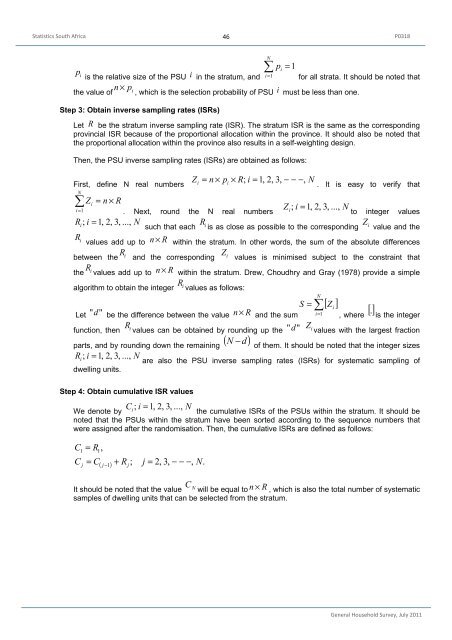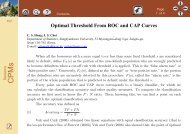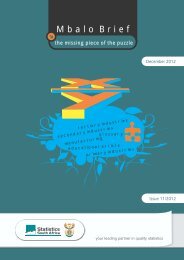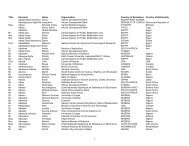General household survey - Statistics South Africa
General household survey - Statistics South Africa
General household survey - Statistics South Africa
Create successful ePaper yourself
Turn your PDF publications into a flip-book with our unique Google optimized e-Paper software.
<strong>Statistics</strong> <strong>South</strong> <strong>Africa</strong> 46<br />
P0318<br />
p i is the relative size of the PSU i in the stratum, and<br />
n ×<br />
the value of<br />
i p<br />
N<br />
∑<br />
i=<br />
1<br />
pi<br />
= 1<br />
for all strata. It should be noted that<br />
, which is the selection probability of PSU i must be less than one.<br />
Step 3: Obtain inverse sampling rates (ISRs)<br />
Let R be the stratum inverse sampling rate (ISR). The stratum ISR is the same as the corresponding<br />
provincial ISR because of the proportional allocation within the province. It should also be noted that<br />
the proportional allocation within the province also results in a self-weighting design.<br />
Then, the PSU inverse sampling rates (ISRs) are obtained as follows:<br />
Z n p R i<br />
N<br />
First, define N real numbers i = × i × ; = 1,<br />
2,<br />
3,<br />
− − −,<br />
. It is easy to verify that<br />
N<br />
∑ Zi<br />
= n × R<br />
Z i N<br />
i=1<br />
. Next, round the N real numbers i ; = 1,<br />
2,<br />
3,<br />
...,<br />
to integer values<br />
Ri ; i = 1,<br />
2,<br />
3,<br />
..., N<br />
such that each i R is as close as possible to the corresponding i Z value and the<br />
R i values add up to n × R within the stratum. In other words, the sum of the absolute differences<br />
between the i R and the corresponding i Z values is minimised subject to the constraint that<br />
the i R values add up to n × R within the stratum. Drew, Choudhry and Gray (1978) provide a simple<br />
algorithm to obtain the integer i R values as follows:<br />
S = Zi<br />
Let "d " be the difference between the value n × R and the sum i 1 , where [] . is the integer<br />
function, then i R values can be obtained by rounding up the "d " i Z values with the largest fraction<br />
( )<br />
parts, and by rounding down the remaining d N −<br />
of them. It should be noted that the integer sizes<br />
Ri ; i = 1,<br />
2,<br />
3,<br />
..., N<br />
are also the PSU inverse sampling rates (ISRs) for systematic sampling of<br />
dwelling units.<br />
Step 4: Obtain cumulative ISR values<br />
C i N<br />
We denote by i ; = 1,<br />
2,<br />
3,<br />
...,<br />
the cumulative ISRs of the PSUs within the stratum. It should be<br />
noted that the PSUs within the stratum have been sorted according to the sequence numbers that<br />
were assigned after the randomisation. Then, the cumulative ISRs are defined as follows:<br />
C = R ,<br />
C<br />
1<br />
j<br />
1<br />
= C<br />
( j − 1)<br />
+ Rj<br />
; j = 2,<br />
3,<br />
− − −,<br />
N.<br />
It should be noted that the value N C will be equal to n × R , which is also the total number of systematic<br />
samples of dwelling units that can be selected from the stratum.<br />
N<br />
∑<br />
=<br />
[ ]<br />
<strong>General</strong> Household Survey, July 2011















